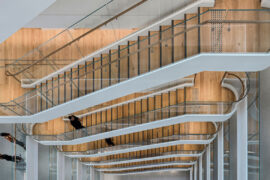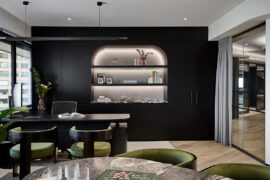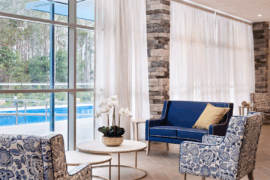A leading workplace consultant, James Calder, the founder of Calder Consultants, talks workplaces of the future with Indesignlive.

James Calder brings a sociological approach to workplace consulting, which is backed up with over 30 years of experience in the sector. It’s safe to say that he knows a thing or two about ever-changing offices – and the design behind them.
We get the lowdown on what James thinks is just around the corner for workplace design.
James Calder: They’re not even recognisable anymore. Funnily enough, the debate around workplaces is still pretty average though – like open-plan doesn’t work.
But the workplace has changed enormously, for example, co-working hubs are now considered a viable workplace, it has just taken a long time for them to be turned into a business reality.
I think that people accept changes easily enough. But in Australia, it comes down to the way we own things. Most companies just rent space, they won’t go and develop their own building. Our models are basically generic property-type models, and more and more the big corporates just outsource all the property to someone else.
So to put some precision around the question, I think the agile American model of a flexible workplace model for corporates is just going to keep getting more and more extreme.
Some of our big clients, which are some of the biggest companies in the world, will just settle down to core buildings in key locations, and they’ll probably go to WeWork for 80 per cent of their workforce. That’s about as agile as you can get. Or they’ll create their own agile model.
The Googles and whatever, they’ll just continue to create Googleplexes all around the world, making their own little bubbles. It’s much more than just the physical, it’s the whole experience of working there, it’s the virtual community, the physical community, all of that will get more and more sophisticated and kind of fine-tuned for each organisation.
Then you’ll end up with a plethora of all different types of workplaces, just like there are all types of bars and restaurants and apartments, and people choose and settle in whatever suits them.
Definitely. It depends very much on the business. So, once again, the inane debates about, “should you let people work flexibly or should you tie them to a desk?” It is totally dependent on the work that they’re doing. Also to my mind, it’s all about teamwork.
I think a growing area will be around virtual teams and communities, and I think we’ll start to actually transition the corporate model to a totally different structure of communities and space.
So if you take banking, for instance, I think we’ll move away from this big banking organisation structure and we’ll align ourselves with a banking community like the exchange communities, such as bitcoins. You know, banks don’t work very well across global boundaries.
Another example is with lawyers. Law practices used to have five floors of lawyers, now you’ve got two floors, and people are now setting up law firms where everyone’s working from home and they get together a day a week.
The whole structure of business is morphing into something different, moving away from the hierarchal scenario.
Buildings, for example will continue to be decentralised. Already you can have engineers designing a building management system to plug the lifts into and manage it all in the cloud. The lift doesn’t even get owned by the building, the lift provider designs the lift, you pay to use it, and they manage 30,000 lifts around the world, through the cloud.
People are always asking me what impact is artificial intelligence going to have on buildings. If I look at the microcosm and what might set our group [Calder Consultants] apart is that we’ve got anthropologists and sociologists that are fascinated with understanding exactly how teams are working. Whereas I find the design community is totally disinterested, they just want know what the product is. At the end of the day, human interrogation won’t be replaced by robots.
Absolutey, and anthropology. The things that don’t change are: human physiology, the evolution of our brains and how we’re wired. I think we constantly have to come back to the human side of it and a basic question like, “what is the problem we’re trying to solve?”
I think as designers we have to keep refreshing our thought processes to go, “well, what is the actual problem?” So, if designers think the problem is, “which furniture product should I be recommending for this client?” They probably haven’t asked the right question, which is, “well, how will this business’ people change and evolve and how do they need to work?”
And in terms of agile, it’s a bit of a cop-out to say, “well let’s just make it all agile and put everything on wheels.” That doesn’t solve half the problems.
–
Never miss a beat from the design industry, sign up for our newsletter.
INDESIGN is on instagram
Follow @indesignlive
A searchable and comprehensive guide for specifying leading products and their suppliers
Keep up to date with the latest and greatest from our industry BFF's!

A longstanding partnership turns a historic city into a hub for emerging talent
The new range features slabs with warm, earthy palettes that lend a sense of organic luxury to every space.

London-based design duo Raw Edges have joined forces with Established & Sons and Tongue & Groove to introduce Wall to Wall – a hand-stained, “living collection” that transforms parquet flooring into a canvas of colour, pattern, and possibility.

For Aidan Mawhinney, the secret ingredient to Living Edge’s success “comes down to people, product and place.” As the brand celebrates a significant 25-year milestone, it’s that commitment to authentic, sustainable design – and the people behind it all – that continues to anchor its legacy.

Mim Design and Konstance Zaharias collaborate to design an interior for a unique context: the chambers of a King’s Counsel in Melbourne.

Jesse Lockhart-Krause, Director of Lockhart-Krause Architects, tells us about a storied building in Queensland that has now become a functional workplace for a therapy centre.

Brad Krauskopf, CEO & Founder of Hub Australia, tells us about Hassell’s design for Hub Australia Martin Place.

Setting the tone for McCormack’s HQ is Elton Group’s Eveneer WoodWall and Eveneer Raw in Ravenna – wrapping walls, ceilings and bespoke joinery in a dark, matte elegance. The seamless pairing delivers a cohesive, high-performance finish that anchors Studio 103’s luxurious, hotel-inspired workplace design.
The internet never sleeps! Here's the stuff you might have missed

Inspired by an unthinkable design challenge on Sydney Harbour, Materialised’s ingenuity didn’t just fuse acoustic performance with transparent finesse – it forever reimagined commercial curtain textiles by making the impossible possible.

With its new Series 8 Ovens, Bosch leverages the intuitive appeal of quiet efficiency to address the most pressing challenge of a modern home chef: making healthy cooking not only delicious but quick, effortless and inspired.